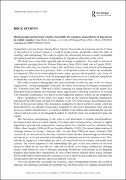Having people, having heart: charity, sustainable development, and problems of dependence in central Uganda
Abstract
China Sherz’s Having People, Having Heart: Charity, Sustainable Development and the Problem
of Dependence in Central Uganda is a work of social science, specifically within the fields of
sociology and anthropology, that seeks to explore the relationship between so-called sustainable
development and the continuation of dependence by Uganda on other parts of the world.
The book uses a case study approach and the design is qualitative. The study is situated in
communities emerging from the National Resistance Army (NRA) bush war in Uganda (1981–
1986). The study uses two charities, Hope Child and Mercy House, both located in the Buganda
Kingdom, to explore three key questions: What are the political stakes of charity and sustainable
development? What is the relationship between charity, poverty and inequality? And, lastly, do
those engaged in charity have a stake in keeping people in poverty so as to maintain a population
to whom they can distribute the alms necessary to achieve their own salvation?
The author combined ethnographic and survey methods to study the case of the two charity
organizations. During ethnographic fieldwork, the author lived among 20 Buganda communities
for 13 months (from 2007–2008 and in 2010), observing the routine practices of the people. Key
informants from European and American donor organisations with long experience of working
with vulnerable communities were drawn on for background purposes, follow-up and comparison.
Sherz’ justification of her study area makes sense as the selected Buganda communities
experienced the NRA bush war and were hard hit by the HIV/Aids scourge, thus attracting many
NGOs in the recovery period. This situation is comparable to that in northern Uganda which has
been affected by two decades of atrocities committed by the Lord’s Resistance Army and thus
possesses similar characteristics. It would be helpful if the author had mentioned the specific
villages and sub-county in the Buganda Kingdom in which the study was conducted to guide the
readers.
Collections
- Book Reviews [1]

